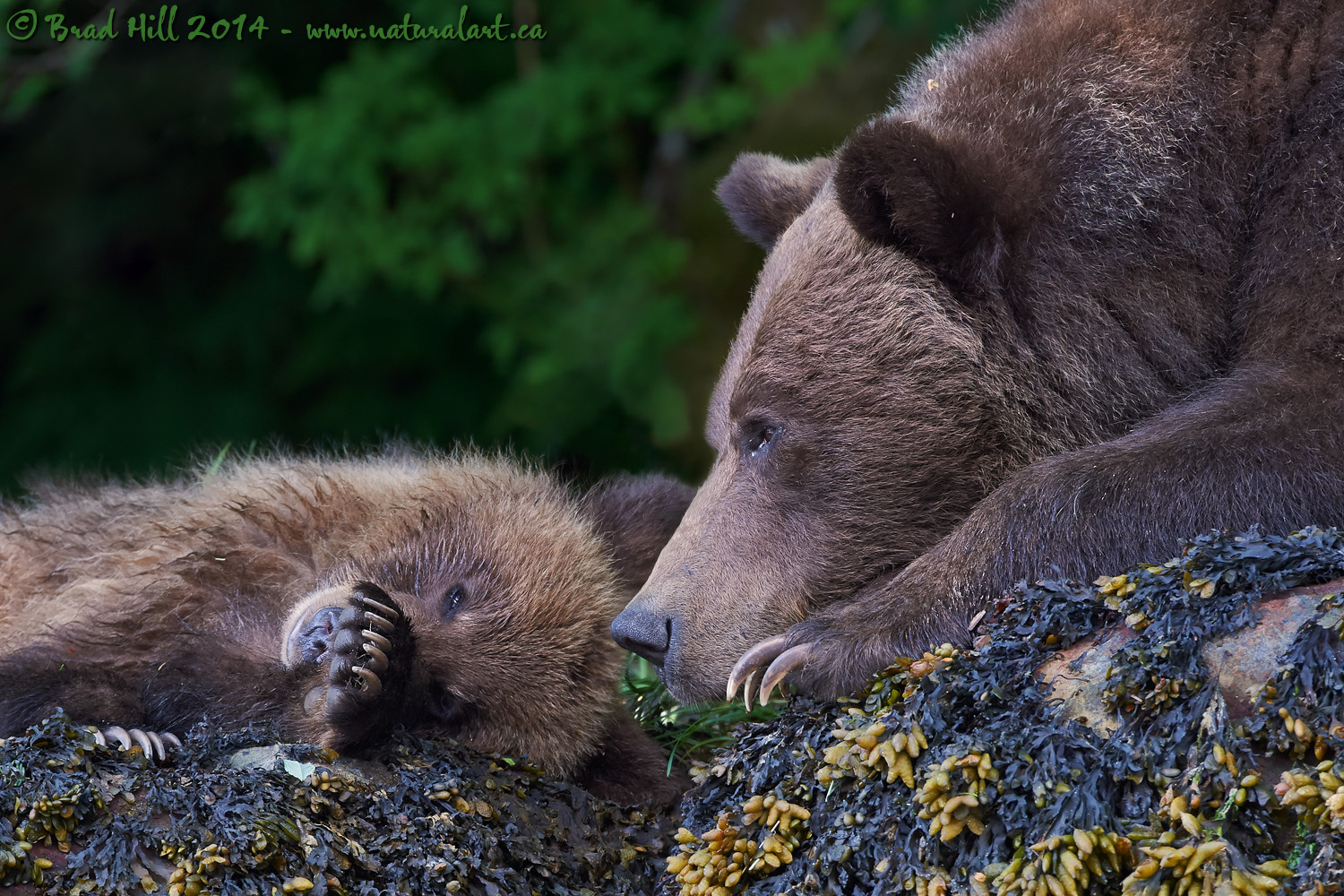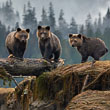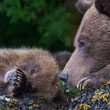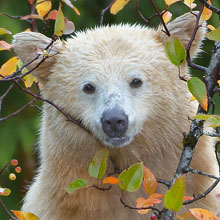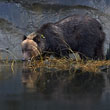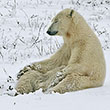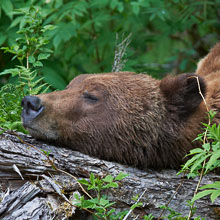Availability: Undetermined - Enquiries?
In the Field
Trusting Ma's Watchful Eye. Khutzeymateen Grizzly Sanctuary, northern BC coast (Great Bear Rainforest), Canada. June 1, 2014.
The complex relationship between a mother bear and its young is an amazing thing to behold. For the first three years (or so) of its life a young bear relies upon Ma for nearly everything - food, security, companionship and more. The trust and faith a cub shows in its mother to keep it safe is complete and absolute.
Cubs, like all young and growing animals, need a whole lot of sleep. And when they do go to sleep, they tend (unlike adult bears) to totally crash and are pretty much oblivious to the world. Ma bear, on the other hand, doesn't allow herself the luxury of a deep sleep when her cubs are out and exposed - she may lay down and rest and occasionally close her eyes, but her ears and nose are continuously twitching and active, and every few minutes she opens her eyes and glances around, always vigilant...
In this shot I attempted to show a bit of the complex relationship between the ever-trusting cub (who is currently totally zonked out and fully in dreamland!) and the ever-alert and protective mother bear. Hopefully it works for you...
Some may find the technique I used to capture this shot interesting...
THE SITUATION AND PROBLEM: I shot this image while we were floating in a Zodiac inflatable boat in the Khutzeymateen. Mom had just taken her cubs up off a beach (where they have been clamming for a few hours) and onto a rock located near the high-tide line for some well-deserved downtime. In doing so she positioned herself plus two cubs quite close to us (this image was shot with a 380mm focal length and is about 95% full-frame!). Long story short, once the bears got themselves settled down they were positioned ALMOST perpendicular to us, but mom was very slightly closer to us than junior was (junior's outstretched claws in front of its nose were on the same plane of focus as mom's nose and profile, but the cub's mostly closed eyes and forehead were about 8-10 cm further back). When I looked at this scene - I REALLY wanted mom's face and both junior's claws AND face in focus but the background soft. But, I knew that at the distance we were away from the bears that the aperture needed to soften the background would leave junior's facial region a little out-of-focus. What to do? Stopping down (to f16 or smaller) would have thrown me into a pretty lofty ISO zone and I had no more shutter speed to give up (don't forget that I was shooting this while hand-holding a 380mm focal length lens while standing on an unstable surface - a floating Zodiac - and was already down to 1/125s). And, of course, shooting at f16 would also make the background a lot less soft and potentially more distracting. Hmmm...
MY SOLUTION: So I thought for a few seconds about my options and then acted! And here's what I did:
1. I focused my camera on mom's eye and snapped off a short burst of shots and then (without moving the camera), I quickly toggled my focus bracket over to junior's eyes and shot another burst.
2. Later, after picking the sharpest shot from each burst (one with mom tack-sharp, the other with junior's face tack-sharp), I processed each raw file separately but with identical adjustments.
3. Next, I opened the two 16-bit TIFF versions of the images in Photoshop and combined them into a single image file (with each image as a separate layer). Of course, despite my best efforts, I HAD moved the camera between shots and the two layers' didn't line up perfectly. Well...because the bears had not moved between the shots, Photoshop's "Auto-Align Layers" function was able to bring the two layers (i.e., the two different images) into perfect alignment. From that point it was a simple matter to blend the two images (using some simple masking techniques to include the sharpest regions from each shot).
Simple as pie - right?
ETHICAL CONCERNS? So what you're looking at is a composite shot - kind of the focal-plane equivalent of a HDR shot. Is this kind of "digital voodoo" legitimate (or even ethical)? Ask 10 photographers and you'd probably get 10 different answers - with everything from a firm and emphatic "No way" through to a blasé "Of course - why even ask?".
I have two thoughts on these sorts of digital adjustments (or, if you will, manipulations). First, the KEY thing is to disclose what you've done - simply own up to it and let the viewer decide. Second, what I have done here is really simply using technology to overcome an optical limitation of the lens - not change the scene. What is shown here is exactly what my eye saw (two bears in perfect focus), but what my lens couldn't quite render. The exception to this is the background - our eyes don't blur and soften backgrounds nearly to the extent that telephoto lenses do. And, if shooting multiple images of a scene at different exposures and then combining them (often using HDR software) into a single image with a wider dynamic range (or brightness range) is a legitimate way to overcome limitations of our image sensors, then why isn't this technique similarly acceptable (all it did was overcome the a limitation of the lens in use). An alternate approach could have been to shoot the same shot using a wider angle lens and a higher resolution camera (e.g., a D800) and then simply crop the resulting shot (all while keeping BOTH bears in focus). Same end result, just a different pathway. Anyway - it's good food for thought...
The detail in this shot is pretty delectable, so here's a higher resolution (2400 pixel) version of it for your perusal:
• Trusting Ma's Watchful Eye: Download 2400 pixel image (JPEG: 1.5 MB)
NOTE 1: This image - in all resolutions - is protected by copyright. I'm fine with personal uses of it (including use as desktop backgrounds or screensavers on your own computer), but unauthorized commercial use of the image is prohibited by law. Thanks in advance for respecting my copyright!
NOTE 2: Like all wildlife images on this website, the subject is fully wild and completely unconstrained. Besides the potential impact of my presence, nothing has been done to intentionally alter or affect the ongoing behavior of the subject and, of course, there has been no use of any form of bait or other form of wildlife attractants (including vocalizations).
NOTE 3: This image was captured during one of my "Grizzlies of the Khutzeymateen" photo tour in the spring of 2014. Each year I offer trips into two different parts of the Great Bear Rainforest as well as one to photograph aquatic mammals and oceanscapes near the northern tip of Vancouver Island. And, in selected years, I also offer photo tours to locations to capture other highly sought-after subjects, such as various boreal owl species and wildlife of Canada's Arctic. Details about these trips can be found on the Photo Tours page of this website.
Behind the Camera
Trusting Ma's Watchful Eye. Khutzeymateen Grizzly Sanctuary, northern BC coast (Great Bear Rainforest), Canada. June 1, 2014.
Digital Capture; Compressed RAW (NEF) 14-bit format; ISO 1800.
Nikon D4 paired with Nikkor AF-S 80-400mm f4.5-5.6 VR @ 380mm - hand-held from floating Zodiac. VR on in Active mode.
1/125s @ f9; -0.67 stop compensation from "recommended" matrix-metered exposure setting.
At the Computer
Trusting Ma's Watchful Eye. Khutzeymateen Grizzly Sanctuary, northern BC coast (Great Bear Rainforest), Canada. June 1, 2014.
RAW Conversion to 16-bit TIFF, including first-pass/capture sharpening using Phase One's Capture One Pro. Note that this is a composite image of two separate image captures with slightly different points of focus, but each image is derived from a single variant of its original raw file.
Further digital corrections on resulting 16-bit TIFF files using Adobe's Photoshop CC 2014. Photoshop adjustments included compositing (blending) of the two output files from the raw converter (after aligning the image layers using Photoshop's Auto-Align Layers feature), further slight exposure adjustments/tweaks, minor colour tweaks (including selective saturation and desaturation and minor hue rotations), and selective sharpening for web output.
Conservation
Trusting Ma's Watchful Eye. Khutzeymateen Grizzly Sanctuary, northern BC coast (Great Bear Rainforest), Canada. June 1, 2014.
Ten percent of the revenue generated by this image will be donated to Raincoast*.
Species Status in Canada**: Special Concern (May 2002).
While Grizzly Bears (Ursus arctos) are not technically listed as "Endangered" in Canada, they have been extirpated from most of their historical range. Grizzly Bears are far more sensitive to intrusion/disturbance in their habitat than are Black Bears and are being increasingly forced into marginal habitat by human encroachment. The Great Bear Rainforest along the central and northern coast of British Columbia is one of the last strongholds of the Grizzly Bear in Canada, and even this population is coming under increasing pressure.
On December 18, 2017 the government of British Columbia banned grizzly hunting across the entire province. This major conservation victory came after decades of tireless work by many dedicated conservationists and ecologists and, most importantly, it reflects the opinion of the vast majority of British Columbians. And, it means that AT LEAST while the current government remains in power grizzlies are finally "safe" in British Columbia.
Now that we've at least temporarily won the battle to save grizzlies in BC, it's time to re-focus our efforts toward protecting ALL of BC's carnivores, including Gray Wolves, Black Bears, Cougars, Wolverines, and more! Simply put, there are no ecological, economic, or ethical arguments supporting the trophy hunting of carnivores.
In a great first step towards ending the hunting of carnivores throughout BC the Raincoast Conservation Foundation has developed a program designed to protect ALL carnivores within the Great Bear Rainforest. Details about this program can be found on this page on Raincoast's website. Check it out and, better yet, make a donation to help Raincoast purchase the remaining commercial hunting tenures in the Great Bear!
*The Raincoast Conservation Society (and Foundation) is an effective and efficient organization that has been fighting for protection of this unique habitat. If you are looking for a meaningful way to contribute to the conservation of this amazing ecosystem, Raincoast will provide maximal "bang" for your conservation dollars.
**as determined by COSEWIC: The Committee on the Status of Endangered Wildlife in Canada












